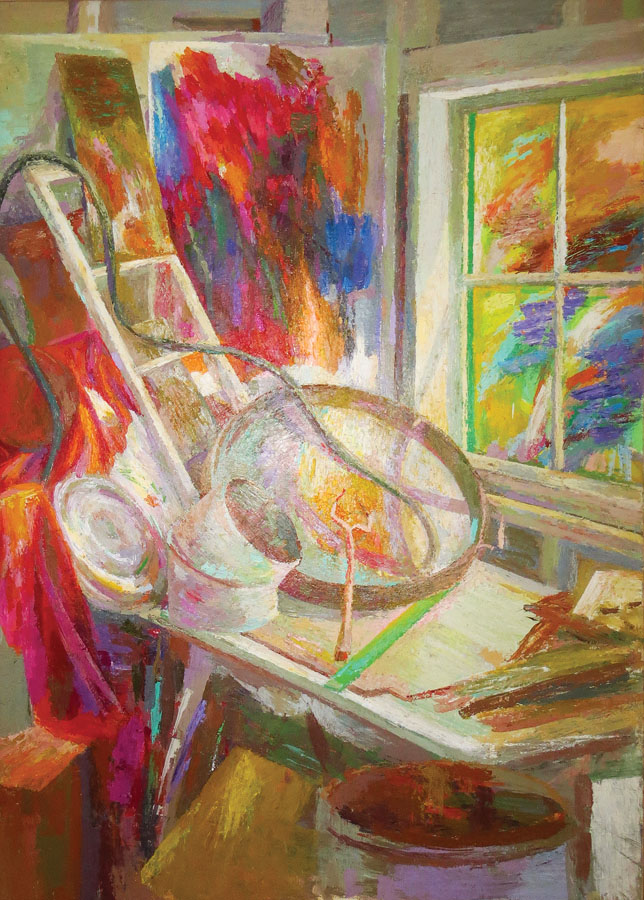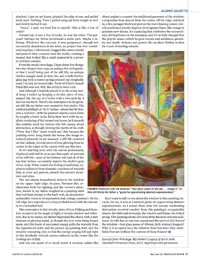Alumni Gazette
 FRAMED: Feinstein calls the window—“four glass panes of vibrant . . . imagery”—in this still life by his father a “guide for appreciating abstract expressionism.” (Photo: Courtesy Sascha Feinstein ’85)
FRAMED: Feinstein calls the window—“four glass panes of vibrant . . . imagery”—in this still life by his father a “guide for appreciating abstract expressionism.” (Photo: Courtesy Sascha Feinstein ’85)In the studio, the scrap metal included hernia-inducing, eight-foot iron bars and other anchor-heavy fragments. He had stored a refrigerator and roughly a ton of cast iron, including all the parts to a cast-iron stove. Two snow plows. The remains of my childhood swing set. Stove piping. Unidentifiable chunks of iron and brass slag. A tiny bit of copper, barely worth the gas money to sell it.
All the metal went to a local sculptor who built castles and landscapes for fairies and sprites. Even with me and his friend helping out, it took him a number of truckloads to move all the metal. . . .
The refrigerator made me laugh. I knew it from childhood, and I remembered my father talking about its arrival: How Dicky Buck, one of the town’s well-known characters, carried it into the house on his back. (Buck did not work for an appliance company; who knows where he got it.) The box conked out during my teenage years, and if I helped my father move it to the studio, I’ve forgotten that memory. But there it was, on its side, the door off and resting elsewhere. The fridge itself was packed full, of course, primarily with two large containers—boxes or crates (I couldn’t tell in the shadow). I got on my knees, gripped the edge of one, and pulled back, hard. Nothing. Then I pulled using my body weight as well and slowly inched it out.
“Jesus,” I said, out loud but to myself, “this is like a box of rocks!”
Turned out, it was a box of rocks. So was the other. The purpose? Perhaps my father envisioned a stone path. Maybe a tabletop. Whatever the concept, it was postponed—though not necessarily abandoned; in his mind, no project was ever considered hopeless. I laboriously dragged the crates outside and poured their contents near the studio, creating a mound that looked like a small memorial in a poverty-stricken country.
From the studio wreckage, I kept about five things: two star-shaped iron cogs; an antique fire extinguisher that I recall being part of his still life; an antique clothes mangle made in Erie, Pa.; and a hefty blown-glass jug with a rusted spring-pressed top (originally used, I’m told, for insecticide). Tomb of K’inich Janaab Pakal this was not. Still, the artifacts were cool.
And although I initially placed it on the scrap metal heap, I ended up keeping a circular piece of iron, shaped like the top of a boiler with a two-inch lip. I have no use for it—but it’s the centerpiece to the greatest still life my father ever created in that studio. The vertical painting’s 47 by 67 inches—about four by five-and-a-half feet—with the painted objects scaled down by roughly a third. As he did in New York with the realistic rendering of the burned-out house, he’d unearth this realistic work for visitors who felt uneasy about abstraction, as though proving the merits of his craft. (“Now that I like,” many would say.) But because the painting never hung inside the house, the image remained primarily in my memory: a still life centered on that radiant, circular piece of iron, glowing from its center to the edges of the canvas with sun-like fury.
So it’s startling now, with the canvas prominently displayed and well lit, to accept that easily 40 percent of the still life—most of the bottom half and all of the top four inches—accurately depicts the studio’s gray wood. Gray. What creates the feeling of uniformly explosive radiance? Four dramatic conclaves of warmth that, in color and gesture, stretch the canvas’s shoulders and arms.
The eye almost immediately turns to the window on the upper right edge; its pane, Vermeer-like, orchestrates both the lighting and the viewer’s attention. Beside it, my father roughed-in a painting start that had been pinned to the back wall, an abstraction undeniably warm in its expression (red, orange, summer). On the left edge, he’s reproduced a drapery that bleeds with the intensity of a beheaded bull.
The centerpiece is that circular piece of iron. Flaking and therefore receptive to the magic of light, it recasts shadow and reflection. But at its center, my father bejeweled the object with a fiery treasure of glowing metal, as though the iron were being forged anew, and this burst of encrusted orange pulls the warmth from the reproduced cloth, and the pinned-up painting start, and the window emanating July, so that the energy surging left and right in this decidedly vertical canvas coalesces in the center like the riveting eye of Kali.
And one can speak of so much more! A wooden, ladder-like object angles to counter the traditional geometry of the window; a serpentine hose dances from the center, off the edge, and back in; a two-pronged firebrand pierces the iron’s flaming center; cleverly positioned streaks of green drive against flame-like orange to generate new drama. It’s a painting that celebrates the extraordinary driving forces in the mundane, and it’s so fully charged that the grayish areas—which he gave texture and substance, geometry and depth—balance and govern like an ideal rhythm section for a host of sizzling soloists.
But I want to talk to you about the window in this painting, because, for me, it acts as a tutelary guide for appreciating abstract expressionism. As I noted, those who felt uneasy confronting abstraction received comfort from this painting’s recognizable shapes: the table and stovepipe, the window and frame, the forked prong. This painting elicits Ah’s even from the most reticent audiences. So why has no one ever questioned the spirit of July beyond the window—four glass panes of vibrant, fully abstract imagery? Why is it accepted once the window itself has been fully established but not without the context of those frames?
Excerpt from Wreckage: My Father’s Legacy of Art & Junk (Bucknell University Press, 2017). Reprinted with permission.

